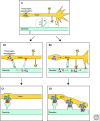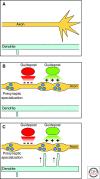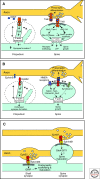Guidance molecules in synapse formation and plasticity
- PMID: 20452946
- PMCID: PMC2845208
- DOI: 10.1101/cshperspect.a001842
Guidance molecules in synapse formation and plasticity
Abstract
A major goal of modern neuroscience research is to understand the cellular and molecular processes that control the formation, function, and remodeling of chemical synapses. In this article, we discuss the numerous studies that implicate molecules initially discovered for their functions in axon guidance as critical regulators of synapse formation and plasticity. Insights from these studies have helped elucidate basic principles of synaptogenesis, dendritic spine formation, and structural and functional synapse plasticity. In addition, they have revealed interesting dual roles for proteins and cellular mechanisms involved in both axon guidance and synaptogenesis. Much like the dual involvement of morphogens in early cell fate induction and axon guidance, many guidance-related molecules continue to play active roles in controlling the location, number, shape, and strength of neuronal synapses during development and throughout the lifetime of the organism. This article summarizes key findings that link axon guidance molecules to specific aspects of synapse formation and plasticity and discusses the emerging relationship between the molecular and cellular mechanisms that control both axon guidance and synaptogenesis.
Figures




Similar articles
-
Magnetic stimulation modulates structural synaptic plasticity and regulates BDNF-TrkB signal pathway in cultured hippocampal neurons.Neurochem Int. 2013 Jan;62(1):84-91. doi: 10.1016/j.neuint.2012.11.010. Epub 2012 Nov 28. Neurochem Int. 2013. PMID: 23201339
-
Microglia regulate synaptic development and plasticity.Dev Neurobiol. 2021 Jul;81(5):568-590. doi: 10.1002/dneu.22814. Epub 2021 Mar 8. Dev Neurobiol. 2021. PMID: 33583110 Free PMC article. Review.
-
Synapse-dependent and independent mechanisms of thalamocortical axon branching are regulated by neuronal activity.Dev Neurobiol. 2016 Mar;76(3):323-36. doi: 10.1002/dneu.22317. Epub 2015 Jun 20. Dev Neurobiol. 2016. PMID: 26061995
-
Molecular Mechanoneurobiology: An Emerging Angle to Explore Neural Synaptic Functions.Biomed Res Int. 2015;2015:486827. doi: 10.1155/2015/486827. Epub 2015 Apr 14. Biomed Res Int. 2015. PMID: 26106609 Free PMC article. Review.
-
Formation and remodeling of the brain extracellular matrix in neural plasticity: Roles of chondroitin sulfate and hyaluronan.Biochim Biophys Acta Gen Subj. 2017 Oct;1861(10):2420-2434. doi: 10.1016/j.bbagen.2017.06.010. Epub 2017 Jun 15. Biochim Biophys Acta Gen Subj. 2017. PMID: 28625420 Review.
Cited by
-
Close Homolog of L1 Regulates Dendritic Spine Density in the Mouse Cerebral Cortex Through Semaphorin 3B.J Neurosci. 2019 Aug 7;39(32):6233-6250. doi: 10.1523/JNEUROSCI.2984-18.2019. Epub 2019 Jun 10. J Neurosci. 2019. PMID: 31182634 Free PMC article.
-
A large-scale behavioral screen to identify neurons controlling motor programs in the Drosophila brain.G3 (Bethesda). 2013 Oct 3;3(10):1629-37. doi: 10.1534/g3.113.006205. G3 (Bethesda). 2013. PMID: 23934998 Free PMC article.
-
Temporal Regulation of Dendritic Spines Through NrCAM-Semaphorin3F Receptor Signaling in Developing Cortical Pyramidal Neurons.Cereb Cortex. 2019 Mar 1;29(3):963-977. doi: 10.1093/cercor/bhy004. Cereb Cortex. 2019. PMID: 29415226 Free PMC article.
-
Mosaic analysis of gene function in postnatal mouse brain development by using virus-based Cre recombination.J Vis Exp. 2011 Aug 1;(54):2823. doi: 10.3791/2823. J Vis Exp. 2011. PMID: 21841766 Free PMC article.
-
Inhibition of coactivator-associated arginine methyltransferase 1 modulates dendritic arborization and spine maturation of cultured hippocampal neurons.J Biol Chem. 2017 Apr 14;292(15):6402-6413. doi: 10.1074/jbc.M117.775619. Epub 2017 Mar 6. J Biol Chem. 2017. PMID: 28264928 Free PMC article.
References
-
- Abe K, Chisaka O, Van Roy F, Takeichi M 2004. Stability of dendritic spines and synaptic contacts is controlled by α N-catenin. Nat Neurosci 7:357–363 - PubMed
-
- Augsburger A, Schuchardt A, Hoskins S, Dodd J, Butler S 1999. BMPs as mediators of roof plate repulsion of commissural neurons. Neuron 24:127–141 - PubMed
Publication types
MeSH terms
Substances
LinkOut - more resources
Full Text Sources
